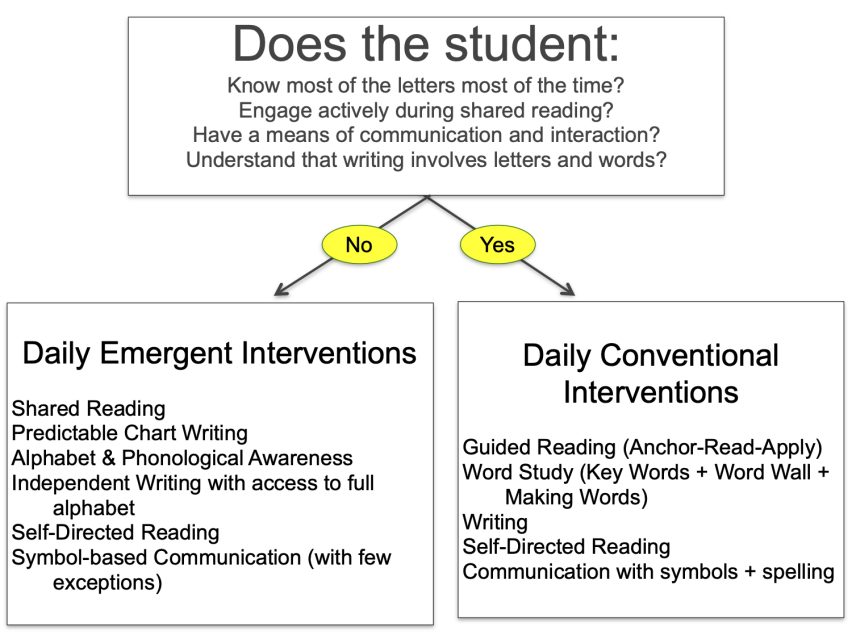This article will give a brief summary of each of the teaching techniques listed in the figure above.
More detailed information can be found here:
7 Key Literacy Strategies
1. Shared Reading (Emergent)
Shared Reading is used to introduce emergent readers to reading. In shared reading, the focus is on interaction, as we model language, conversation, and how books “work”. In the process, we help AAC users learn how to engage with books in an enjoyable and more conventional way.
Ideas for shared reading with emergent learners:
- Comment about the story and pictures as you read.
- Ask open-ended questions or pause to invite a comment in return.
- Model key words using AAC.
- Pay attention to the text as well as the pictures. Point to key words in the text while reading, and use your finger to show how you read from left to right.
- Find books with repetition, with topics that are high interest.
2. Guided Reading (Conventional)
Guided Reading teaches AAC users to focus on getting particular information from a text. It sets a purpose for the reading, before the reading begins.
Ideas for guided reading with conventional readers:
- Picture walk: talk about the pictures before reading the text. Make guesses about what the story is about, who the characters are, etc.
- Always read for a purpose. For example: Choose your favorite page. Make predictions about the stories.
- Read the same story multiple times, for a different purpose each time.
- Find interesting words in the text - What does the word mean? What are some different words that mean the same thing? What is the first sound, the last sound?
- After reading the text use sticky labels to cover particular words e.g. core words/ describing words/ verbs. Work with students to figure out the missing words.
- Find Monarch readers to share with the class, print/share on iPads/interactive whiteboard.
Predictive or inferential questions that can be discussed with each repeated reading include:
- What will happen if ____?
- What will happen next?
- What happened before the story?
- How did the characters feel?
- What do the characters think?
- What other things could the character say?
- Why will ____ happen?
- Why wouldn’t ___ happen?
- How do you think ____ happened?
- How did that happen?
- Think of a different way the story could end
3. Independent Reading (Emergent and Conventional)
All literacy learners need time to select their own books and read independently. For some learners, this may mean flipping through a book to look at the pictures. For others, it may be books on computer or in an iPad app. Learners should have a wide range of books to choose from, and should be allowed to pick their own reading material.
4. Shared Writing (Emergent)
Shared writing is a scaffolded group activity for emergent writers, where we can select the structure of what will be written and then we “think aloud” to model the writing process. Each AAC user contributes a line, using their AAC system.
Predictable chart writing is the most common form of shared writing.
For more information, see Jane Farrall’s blog post on Predictable Chart Writing and The Center for Literacy and Disability Studies handout on Predictable Chart Writing.
5. Independent Writing (Emergent and Conventional)
All AAC users should have frequent opportunities every day to write using the alphabet for real purposes. This means not just tracing letters or practicing writing their name on a worksheet, but writing to accomplish a real purpose. Some examples may include: signing into a activity, writing a story, a letter, a poem, a schedule, rewriting or adding to a favorite book. Most students who use AAC have difficulty forming letters with a pencil, and will need some form of alternative pencil to access the alphabet. This can be a keyboard page that is part of their AAC system, or some other alphabet display. For more information on different alternative keyboards visit the instructional resources section of the DLM website.
For more information, see Jane Farrall’s blog post on Writing, and Writing Strategies used at Willans Hill School.
Another important strategy for beginning writers, is to give informative feedback for AAC users who are not yet conventional spellers. First, we set the topic for the writing assignment. Let the AAC user access his or her alternative pencil to write about the topic. Then give informative feedback to help the AAC user make connections between the letters he has chosen and the content of the picture. See this video for more information about informative feedback.
In addition to writing with the alphabet, AAC users also need experience writing using the vocabulary in their AAC system. This can allow AAC learners to work on higher-level literacy and language skills such as syntax and verb tenses and using language for communication. Not all writing needs to be done with the alphabet.
Ideas for Independent Writing:
- Use Pictello to write your own books using text, photos and videos
- Sentence expansion - add describing words in front of nouns in sentences
- Text innovation - Make vocabulary changes to the text to make variations to the text, eg. Baa Baa Green sheep
- Write text, with the purpose of sending a letter, email, invitation
- Write books, with the purpose of sharing with family, friends, other classes at school, etc.
- Write lists, to organize class activities, e.g. shopping lists, list of people to invite, books to read, activities for free time, favorite things, etc.
- Write treasure hunts
- Write riddles; describe items and people have to guess
- Change one word in a written sentence - make the sentence have the same meaning, OR an opposite meaning
- Write Acrostic poems
- Write cartoons - with speech bubbles - write what characters would say to each other
- Share writing attempts on class whiteboard to give immediate feedback about the writing
- Use graphic organizers to talk about and plan what you want to write before starting
- Make word clouds (www.wordclouds.com)
- Use word webs to write brainstorming ideas about topics
6. Letter and Sound Awareness
All AAC users benefit from increasing their knowledge of letters and letter sounds. Emergent learners need to develop their knowledge of individual letter names and sounds, and conventional learners need to develop knowledge of syllables, separating words into sounds, and onset and rime.
For more information, see Jane Farrall’s blog posts on teaching and learning the alphabet, and working with letters and sounds.
Ideas for Letter and Sound Awareness:
- Read and write alphabet books
- Vote or make choices with letters - when offering a choice between two options, use Post-It notes with the initial letter of each choice (e.g. “c for cookie or d for donut?”)
- Play with letters in a variety of fonts and forms (puzzles, cookie cutters, magnets, light up drawing boards…)
- Sort pictures or objects according to what sound they start with
- Play “I Spy, something starting with __” (use sound or letter name).
- Identify different length words from the text/activity, and break the words into syllables. Clap and/or count the “beats” or syllables in each word.
- Break words into their sounds. Count the number of sounds in the words.
- Find words that rhyme within the text/activity.
7. Spelling - Working with Words
As students become able to identify letters and the sounds they make, it’s time to start putting those letters together to spell words.
For more information, see Jane Farrall’s blog post on working with letters and sounds.
Ideas for Working with Words:
- Word walls and Making words
- Choose key words in the text (e.g. characters, high frequency words, core words), and have students identify first and/or last sounds in words
- Pick top 5 core words and focus on spelling and letters in these words
- Spell sets of word families (rhyming words), see Jane Farrall’s blog post on word families.
- Take key words from the text/activity and make up as many rhyming words as possible
Build literacy skills
Developing literacy skills is crucial for all learners. AAC users, given time, the right tools and teaching strategies, can also acquire these essential literacy skills. It is important that comprehensive literacy instruction is integrated alongside AAC learning. Together these will build language for the AAC user, to give them powerful and independent communication.
Follow the links below for more strategies to build language and communication:
Go to the AssistiveWare Core Word Classroom. All Core word planners contain a section on how to integrate some literacy instruction within different activities.
Links & References
- AssistiveWare Core Word Classroom. (2016). Core Word Planners. [Literacy suggestions within each Core word planner]
- Center for Literacy and Disability Studies. [Website]
- Center of Literacy and Disability Studies. Dynamic Learning Maps. [Website]
- Center of Literacy and Disability Studies. Dynamic Learning Maps Professional Development modules. [Learning modules]
- Center of Literacy and Disability Studies. Project Core. [Website]
- Center of Literacy and Disability Studies. Monarch Reader. [Website]
- Edmonton Regional Learning Consortium. (2016). Literacy Instruction for students with significant disabilities. [Website]
- Erickson, K. (2017). Comprehensive literacy instruction, interprofessional collaborative practice, and students with severe disabilities. American Journal of Speech-Language Pathology, 26, 193–205. doi: 10.1044/2017_AJSLP-15-0067
- Erickson, K. & Koppenhaver, D. (2020) Comprehensive Literacy for All: Teaching Children with Significant Disabilities to Read and Write. Baltimore, MD: Brookes
- Farrall, Jane. Literacy, AAC and Assistive Technology. [Website]
- Farrall, Jane.(2015). Shared Reading: Focus on Interaction. [Blogpost]
- Farrall, Jane. Guided Reading. [Blogpost]
- Farrall, Jane. (2015). Self-selected reading for every learner. [Blogpost]
- Farrall, Jane. Comprehensive Literacy. [Website]
- Koppenhaver & Erickson.(2007). Children with Disabilities: Reading and Writing the Four-Blocks® Way.
- Musselwhite, Caroline & Sheldon, Erin. [2015]. Reading as Communication: Selecting books, Angelman Syndrome Foundation. [Video]
- Willans Hill Literacy. [YouTube channel]





